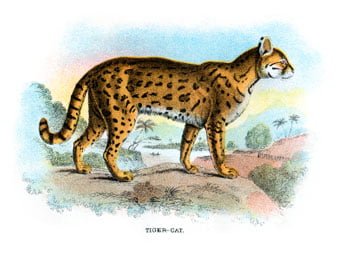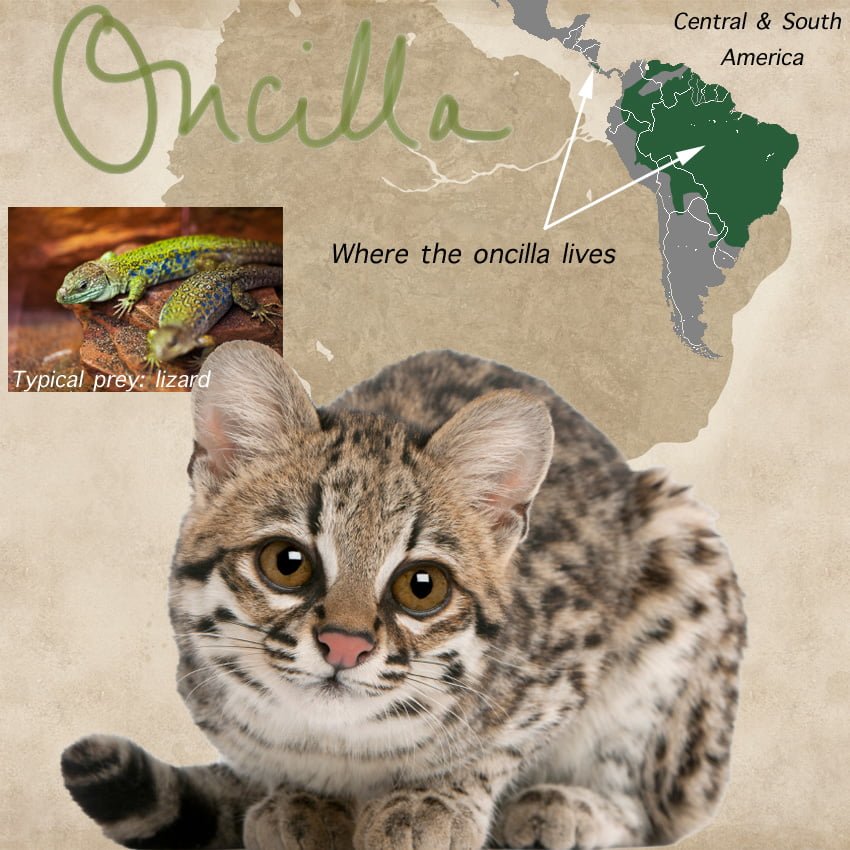
The oncilla is a species of small wild cat. “Species” means a type of wild cat that is different to the other wild cats. Like the cougar, the oncilla has lots of different names such as: little spotted cat, tiger cat, lesser spotted cat and ocelot cat.
As this cat looks like a margay or ocelot the names are also sometimes used for those cats as well. It can be a bit confusing. Also, the oncilla lives in the same places as the ocelot and margay. This cat has been hunted a lot for its fur.
What It Looks Like
The cat weighs from about 3 to 6 pounds (1.5 to 2.8 kilograms). It is one of the smallest of all the 36 wild cats. The fur is thick, soft and beautifully patterned. The coat is covered in ![]() dark spots and shapes called “rosettes”. Rosettes are large spots of different shapes with a hole in the middle. The fur inside the rosettes is darker than the background color to the spots, which is light to dark “ochre” in color. You can see the color of ochre in the picture. Although this cat looks like a margay it is more delicate and smaller than the margay.
dark spots and shapes called “rosettes”. Rosettes are large spots of different shapes with a hole in the middle. The fur inside the rosettes is darker than the background color to the spots, which is light to dark “ochre” in color. You can see the color of ochre in the picture. Although this cat looks like a margay it is more delicate and smaller than the margay.

Where It Lives
The cat lives in Costa Rica and Panama in Central America. Central America is the area between Mexico and the continent of South America. A “continent” is a large area of land that contains many countries. This cat also lives in many of the countries of South America. These are: Argentina, Bolivia, Brazil, Colombia, Ecuador, French Guiana, Guyana, Paraguay, Peru, Suriname and Venezuela.
The sort of place where it prefers to live is probably a forest of some sort, where there is plenty of water and places to hide (cover). However, the oncilla also lives in grassy areas with widely spaced trees. These places are called “savannas”. They also live in dry places where tough plants and trees grow. This happens in Brazil. The oncilla has adapted to different types of habitat. “Habitat” means the sort of place in terms of rainfall, sunshine, trees, grass, other animals and so one, where an animal has chosen to live.
Behavior
As for all cats, this little wild cat is an excellent hunter. It will hunt different sorts of animals. In the picture I have shown a lizard. Oncillas in the northeast of Brazil eat lots of lizards. The prey that the oncilla hunts depends on where it lives. For example, in Costa Rica an oncilla had eaten mice and a shrew and in Venezuela they probably eat more rodents than other animals. People are still not sure how this cat behaves. Although they are good tree climbers, they probably do most of their hunting on the ground.
Sounds
The cat makes sounds that a domestic cat makes and some other special sounds that wild cats make. For example young oncillas purr. Grown up oncillas make a gentle gurgling sound when close to each other.
Kittens and Growth
Mother cats are pregnant for about 75 days. This is longer than usual for a small wild cat. The average number of kittens in a litter is a bit more than one (1.12) After birth kittens open their eyes at 8-17 days of age. At about 11 months of age the oncilla is almost a fully grown cat. Female cats mate and have kittens at about two and a half years of age. A female oncilla in a zoo lived to 17.
Dangers To This Cat
As is often the case for wild cats, the number of oncillas living in the wild is going down each year. This cat avoids areas where the ocelot lives. In the past, a lot of oncillas were killed by people for its fur. This happens much less these days but it still happens. It is illegal to hunt this cat in many countries in South America. For about 30 years, countries have agreed to stop people buying and selling the skin of the oncilla.
Farmers sometimes kill this cat when it attacks their livestock (for example, chickens). And, as usual, people destroy the places where the cat likes to live. This prevents it from living.


My pleasure dw. This is a pretty small wild cat that looks like a domestic cat but I am sure that if we went up to one it would hiss like hell and show all the wild behavior we would want to see.
What a beautiful little wild cat. Thanks for continual education on different cat species. I remember as a little girl flipping through the pages of the encyclopedia brittanica looking at the pictures of animals, plants, trees etc. I get the same satisfaction here on PoC. Thanks, as always.